This article first appeared in the September 2023 issue of EMAg.
Where cows outnumber people, early music finds a foothold. ‘Figuring out practical solutions for rural communities is a really Western way of thinking’
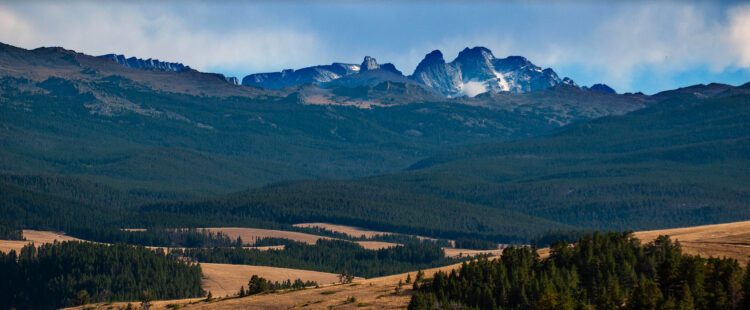
Spotted in the local newspaper: a headline in all caps, “ANIMAL GUT STRINGS.”
It wasn’t going to be Wyoming Baroque’s first performance in Sheridan, Wyo., a town of less than 20,000 people located at the foothills of the idyllic Bighorn Mountains. But it was to be their first performance as part of a regional tour. For the locals, the novelty had clearly not worn off.
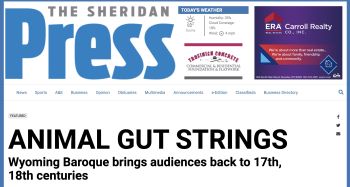
Understandably so — early music is late in reaching much of the Mountain West, and the reasons are no mystery. Wyoming is the least populated state in the U.S. and, along with Montana, one of the two least populated states in the region, with population densities comparable to Siberia. In both states, cows outnumber people by more than two to one. Meanwhile, large metropolitan areas like Denver, about 420 miles south of Sheridan, are few and far between.
Conventional wisdom holds that such locales are inhospitable to up-and-coming music scenes, let alone ones as niche as historical performance. Yet out West, a small but growing number of early-music ensembles like Wyoming Baroque and Baroque Music Montana are rejecting that old logic, establishing firm footholds in small communities nestled in the Rocky Mountains.
Meanwhile, in Denver, the Baroque Chamber Orchestra of Colorado continues to expand their reach beyond the suburbs, reaching high — quite literally — into some of Colorado’s most elevated and remote mountain towns.
While early music may have a short history in the region, the spirit of ingenuity, resourcefulness, and pragmatism that these ensembles embody are longstanding. As rural westerners know well, isolation poses many challenges, musical and otherwise. Yet it may very well be that, for many budding early-music ensembles, the most opportunities will be found in places with the fewest people.
‘Do it Yourself, or Do Without’
In 2015, when he arrived to take up the position of director of strings at Wyoming’s Sheridan College, Mark Elliot Bergman already knew that he wanted to bring early music to the local community. A double bassist by training, Bergman’s interests span the Baroque to the modern and just about everything in between. But when the president of the college asked if he had any ideas for initiatives that could get community members involved, he quickly replied, “Well, we can start a gamba consort.”
Many educators in Bergman’s position would have had to lobby tirelessly to kickstart an early-music program, but the college immediately offered to purchase a chest of viols. “We had a really supportive administration which was willing to put financial resources behind creating an infrastructure that would allow community members to seamlessly transition to a program that supported early music,” Bergman explained. As for the music, he chalked it up to the good old western mentality of “Do it yourself or do without.”
The Sheridan College Viol Consort has, by any measure, been a success. Composed of students in the music department as well as locals interested in early music, they perform several concerts each year. One regular member makes a 120-mile trek down from Billings, Mont., to play with the consort. Another Sheridan College student, Colton Hodge, changed his major to viol performance and went on to continue his degree at Baltimore’s Peabody Institute.
But there was also room, Bergman felt, for a professional early-music ensemble. The opportunity arose when, in 2016, he received a faculty grant to host the musicians who would become Wyoming Baroque, the ensemble Bergman now leads as artistic director.
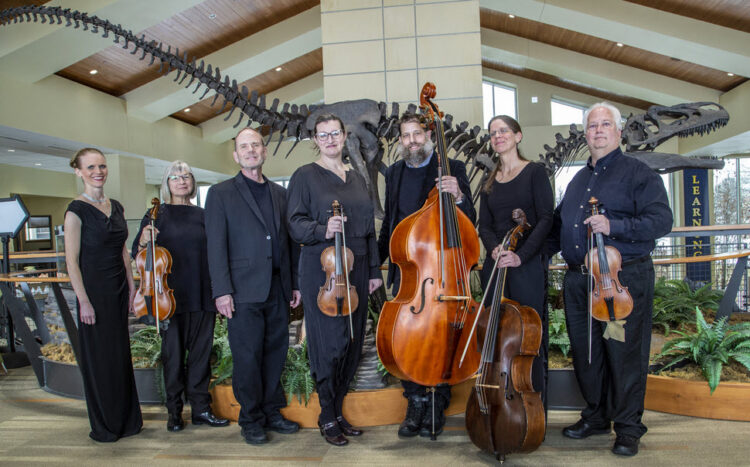
“Part of the reason I decided to go with an early-music group instead of a modern group was that there was such a dearth of early-music awareness in our area,” Bergman remarked. “It also presented the possibility of Sheridan College being a musical incubator that could be exported statewide.”
Since 2016, Wyoming Baroque has performed numerous concerts and recorded three albums: two offering Bergman’s own early-music inspired compositions, and the third featuring the first recording of chamber arrangements of Mozart symphonies by Giambattista Cimador (1761–1805), an Italian composer and instrumentalist who worked primarily in England.
Bergman traveled to the British Library to create his own critical edition of the arrangements, publishing his research in a peer-reviewed Online Journal of Bass Research. The arrangements proved perfect for a small period ensemble hoping to bring Mozart to the mountains. And in a way, there is something about music born in Austria, arranged in England, and finding new life in the most remote parts of rural America that neatly encapsulates what Wyoming Baroque is all about.
There is something about music born in Austria, arranged in England, and finding new life in the most remote parts of rural America that neatly encapsulates what Wyoming Baroque is all about
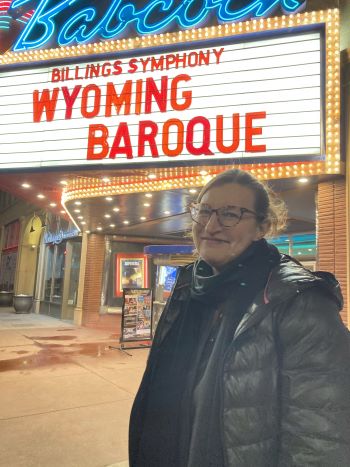
In the spring, the group also completed their first regional tour, marking “a big step forward for Wyoming Baroque,” Bergman said. In addition to the Sheridan concert that prompted the screaming, gut string-related headline, they traveled to Billings, Mont. (hosted by the Billings Symphony), Cody, Wyo. (Buffalo Bill Center of the West), and Laramie (University of Wyoming), all the while engaging with high school and college students in masterclass settings.
As is usually the case in this territory, the tour demanded some unorthodox solutions, namely the use of a digital harpsichord for gigs where a proper acoustic instrument was unavailable.
“I would really like to take this music to smaller communities who maybe don’t have the resources you would have in a major metropolitan area. So we received a grant to purchase a digital harpsichord. Without it, there are simply a lot of places we wouldn’t be able to go.”
While he knows that purists might find it an imperfect solution, Bergman argues, “Figuring out practical solutions for rural communities is a really Western way of thinking about things, and it’s an ethos that pervades a lot of our thinking in Wyoming Baroque.”
At home as well as on tour, audience response has been enthusiastic. The crowds get bigger by the year. In the future, Bergman hopes to organize performances around the church bass, sometimes called the “Yankee bass” or American bass viol. As an instrument once used to accompany church musicians where an organ was not available, it might represent the 19th-century equivalent of a digital harpsichord.
But for the time being, Bergman says, “I’m really proud of the work we are doing with Wyoming Baroque, and I’m also really proud of the way in which institutions and audiences in Wyoming are embracing new ideas and new sounds.”
Early Music at High Elevation
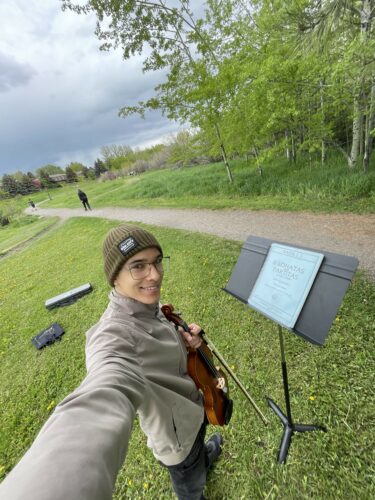
A roughly four-hour drive northwest of Sheridan, along Interstate 90, traces the route of the historic Bozeman Trail, a northern offshoot of the Oregon Trail, as well as the ancestral lands of the Crow, Shoshone, Arapaho, Cheyenne, and Lakota nations, among others. The route will land you in Bozeman, Mont., a mountain town known for its natural beauty and world-class outdoor recreation.
During the COVID pandemic, while enjoying some of the best hiking in the Rocky Mountains, there was a remote but very real chance of being serenaded by Baroque violinist Carrie Krause, artistic director of Baroque Music Montana (BaMM), as part of her “Bach at Trails” outreach series.
This kind of “pop-up style concert,” as Krause calls it, represents one of many out-of-the box (or Bachs) initiatives intended to engage with Montana audiences wherever they are — from ranching communities to remote mountaintops. (And that’s no exaggeration — another series this June paired dance, unaccompanied Bach, and a recent work by wilderness-inspired composer John Luther Adams — all played atop some of Montana’s tallest peaks.)
Krause, who also serves as concertmaster of the Bozeman Symphony Orchestra, could have easily separated her lives as a modern and period performer, traveling to make regular appearances with groups like Apollo’s Fire and the Seattle Baroque Orchestra.
But she, too, felt a need to bring early music home, explaining, “I just wanted to play this music in a place I love, for a community that I love, with wonderful musicians. I also knew that musicians would have a hankering to play music out here as well.”
In 2015, Krause arranged a tour, inviting colleagues from out of state and booking enough performances to cover travel costs and pay musicians — not always a given. “But it eventually got to a point when, instead of just dividing the pot at the door, I asked, ‘Can we grow this, make this more sustainable rather than just having it be a one-off thing? To have it become something meaningful not just for the musicians, but meaningful for this community, for the state of Montana and beyond?’”
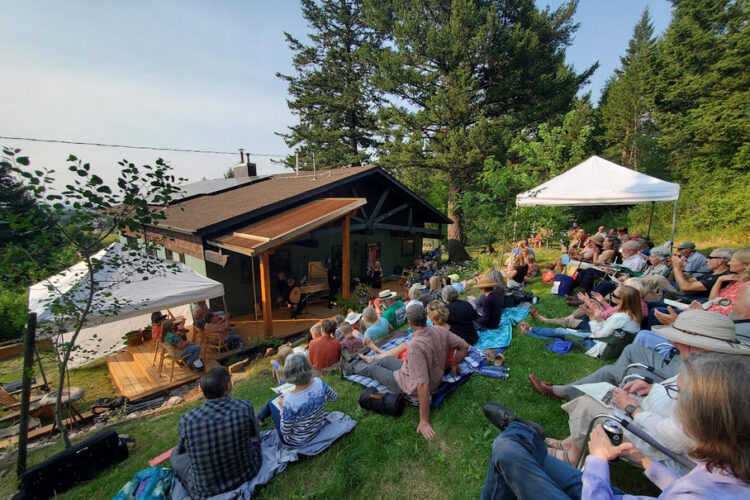
Gauging by the warm reception from local audiences, the answer is yes. “They really love it!” Krause exclaimed, recalling how “one man, in particular, in Columbus, Montana, who said, ‘Before this, I only liked two kinds of music: country and western. But I really like your music!’”
Krause figures that, as opposed to widely understood designations like “classical music” or “chamber music,” the “early music” signifier doesn’t mean much to BaMM’s first-time attendees. But the atmosphere, tunes, and level of audience engagement keep listeners in their seats and coming back for more, in part because they combat the notion of classical music concerts as stuffy, formal, and invariably serious. It’s an attitude they take to concert halls as much as house performances, where the musicians can quite literally join the party.
“It’s about establishing that we’re not pretentious. We are friendly, charming people, and there’s humor to be enjoyed in this music. There’s a focus on beauty, and also a dance element that allows for a great sense of groove. The improvisatory and ornamentation aspect makes the music fresh and alive. And it’s chamber music, where you can see a back and forth, an incredible conversation, happening between dear friends. It’s an entertaining, welcoming, and high-energy environment.”
But it’s not just about putting on compelling performances and charming audiences. It’s also about making concerts logistically accessible to Montanans, an effort that requires partnerships with organizations and individuals across the state.
“It’s all relationship based,” Krause explains. From the organization’s inception, “It was really key for our success that, wherever we went, there was somebody, or a group of people, who I knew could help advocate for our concert and spread the word, or to help finance it.”
Krause’s network has allowed BaMM to reach communities whose populations barely exceed that of a modern symphony orchestra: “You go into these seemingly dead, really tiny towns. But when you walk into the school you realize that it’s full of energy.” Closer to home, a partnership with Intermountain Opera Bozeman will allow BaMM to perform the region’s first fully staged Baroque opera, Monteverdi’s L’incoronazione di Poppea. And, every year, BaMM hosts a workshop that welcomes amateurs and professionals interested in the world of historical performance.
No matter the repertoire or medium, home always figures heavily into BaMM’s programming. Krause looks forward to an upcoming performance in Montana towns like Twin Bridges (population 300) and Basin (population 267), where she will perform the work of Corelli, who was famously an avid art collector, in spaces highlighting the work of local visual artists and artisans.
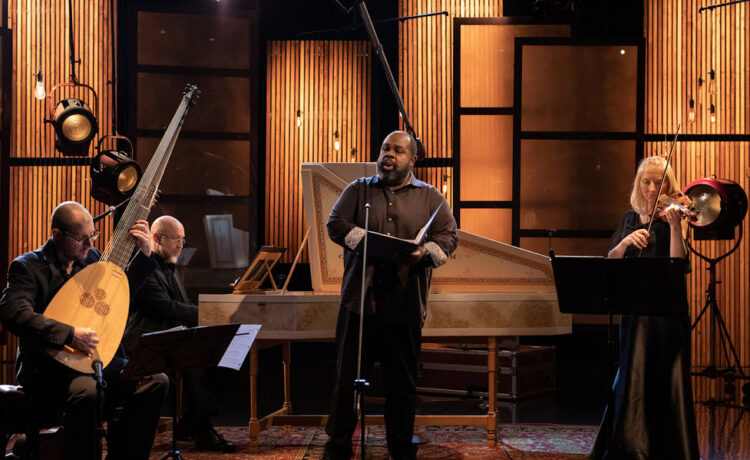
Local inspiration even finds its way into recording projects. A new album from Krause and theorbist John Lenti, Sonata Tramontana, offers a distinctively alpine feel. Though the music is European in origin, hailing from 17th-century composers living in the Alps, the impetus comes directly from a love of the Rocky Mountains.
Whether in-person or on a CD, Krause concludes, “The opportunity to be able to choose music that you want to play and create employment for musicians that you admire and learn from, and to be able to play this music in a place I love so deeply, is just an absolute dream come true.”
Beyond City Limits
Compared to Wyoming Baroque and Baroque Music Montana, Denver’s Baroque Chamber Orchestra of Colorado represents — to use a literary trope from Western novels — the more established, older sibling who moved away to live in the big city. But while the bulk of its concerts might understandably be concentrated in the Denver area that it calls home, BCOC traverses the entire state.
Since its inception in 2005, “We’ve always had in our mission that we would bring Baroque music to Colorado communities,” says Frank Nowell, BCOC’s founder and artistic director. “And that’s something that we take seriously.”
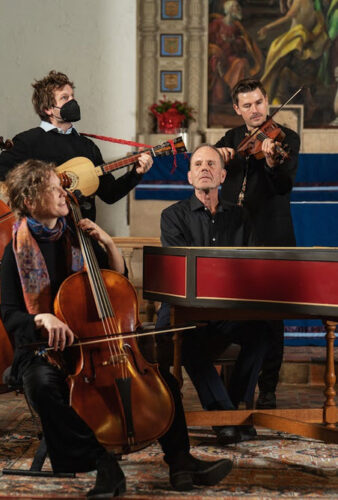
At around 5.8 million people, Colorado’s population may be significantly larger than that of Wyoming or Montana, but nearly half of its inhabitants are concentrated in and around Denver, with another 750,000 or so in the Colorado Springs metropolitan area just an hour south. That leaves about 2 million spread out in the small mountain towns and agricultural communities that dot the state — a huge area of land.But for nearly two decades, Nowell has found that audiences in remote communities — places like Grand Junction or Winter Park — are often the most eager to hear their performances. They are also receptive to a field of music that even many classical musicians find puzzling: “There’s really an inquisitive spirit in these audiences. They just respond immediately to the music.”
In addition to creative programming, such as a recent concert series that melded early music with elements of Appalachian folk tunes, Nowell stresses the importance of pre-concert talks, talkbacks, or even just informal chats after the performance. “And to me, as a musician, that’s one of the most satisfying things. I love our concerts in Denver, but to have that connection, where someone is maybe experiencing historical performance for the first time or is hearing a particular piece or composer for the first time — and then responding to it, asking questions and wanting to know more — it’s just a really, really gratifying thing.”
Any ensemble, Nowell argues, should balance maintaining a core audience with outreach efforts, observing that “both are needed in a healthy balance. The latter may seem more risky, but it’s so vital.” Not every ensemble has to establish a home base far from urban centers, but he says that musicians looking to bring early music to cities within largely rural states — places like Tulsa, Okla. or Lincoln, Neb. — might find much of their base outside city limits.
For musicians used to chasing a crowd, that prospect might seem daunting. But it’s worth noting, too, the level of cooperation and support that can emerge through regional networks. For instance, BaMM has performed at Wyoming’s Sheridan College, and Krause has crossed state lines to play with Wyoming Baroque. Bergman is a member of Denver’s BCOC, and Nowell joined Wyoming Baroque on their recent tour. The web of connections is long.
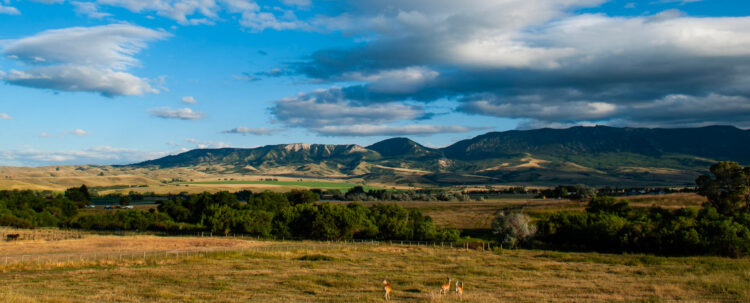
If he were to offer words of encouragement to new ensembles looking to embrace this kind of model, Nowell says, “I just have this faith, this kind of core belief that this music is accessible. It’s easy to understand, and to enjoy. That would be my advice to those ensembles — to believe that there’s an audience there. And then, whatever you do musically, make sure that it’s connected into the community, because every community is different.”
Ultimately, cooperation — both with each other and with their communities — is what allows Wyoming Baroque, Baroque Music Montana, and the Baroque Chamber Orchestra of Colorado to not just survive, but thrive. By engaging audiences in creative ways, partnering with local stakeholders, and envisioning their surroundings as sources of inspiration instead of inconveniences to be overcome, they don’t just bring early music to the American West. They make early music of the American West.
Jacob Jahiel is a writer, editor, and viola da gambist residing in Baltimore. He grew up in the Big Horn Mountains of Northern Wyoming.

